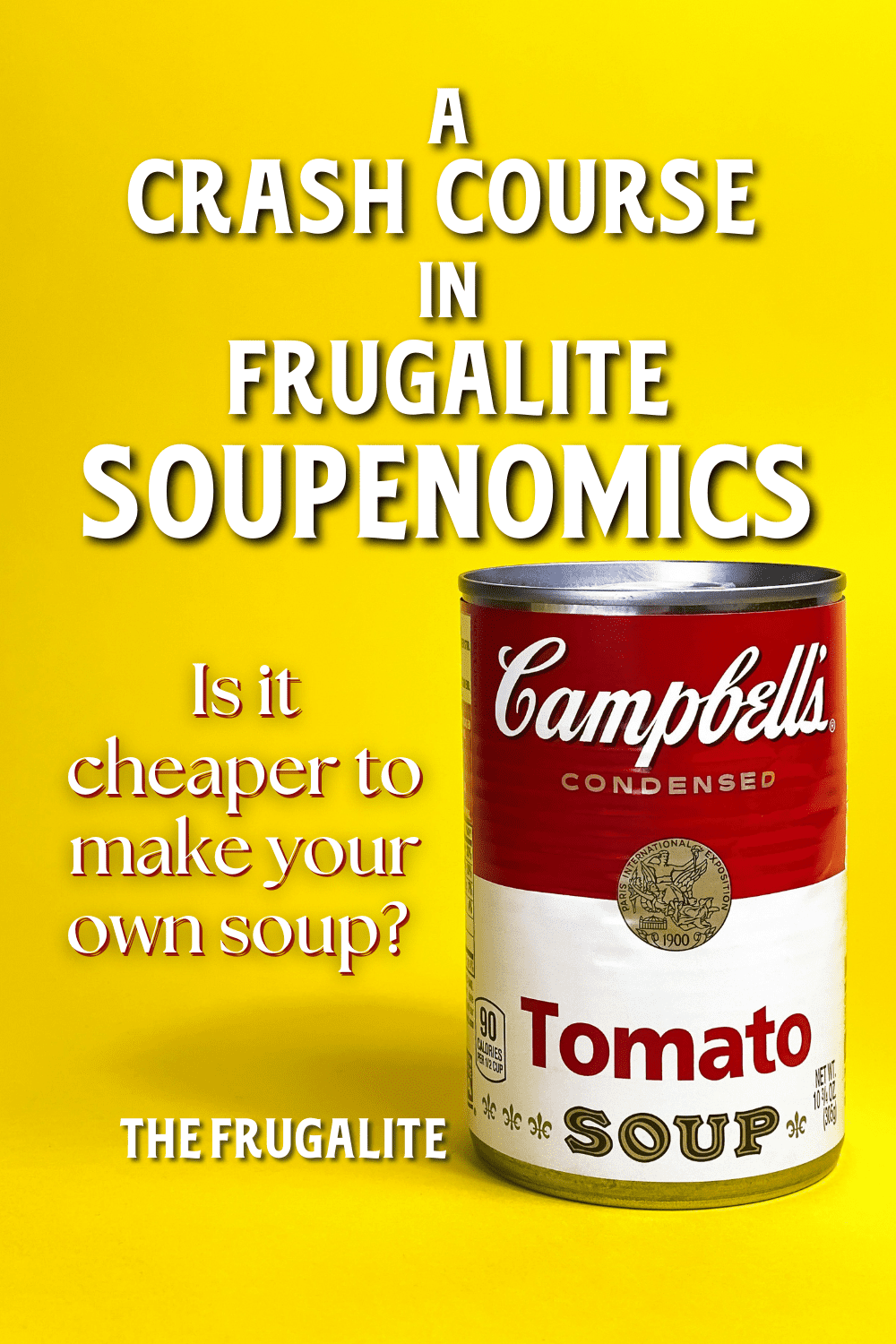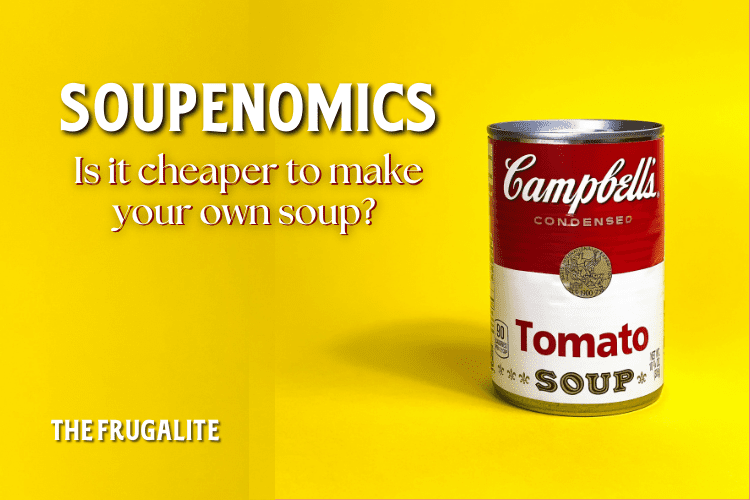(Psst: The FTC wants me to remind you that this website contains affiliate links. That means if you make a purchase from a link you click on, I might receive a small commission. This does not increase the price you’ll pay for that item nor does it decrease the awesomeness of the item. ~ Daisy)
By the author of the FREE online course Growing Self-Sufficiency: The Whole Picture
Last night, I made a huge kettle of low-cost soup. Realizing that I now had enough soup for about a week of dinners, that got me thinking about the cost of soup at the supermarket and what other options are available.
Dear Frugalites, I hope you enjoy my thoughts about the cost of soup in these high-priced times. I know that many of you are accomplished cooks, so please chime in with your own frugal soup tips and tricks in the comments at the end of this article.
Soup Prices Then…..and Now
It used to be that buying a can of soup was the least of my worries at the supermarket. A can of brand-name soup was well under a dollar, and I could literally throw several into my cart without giving it a second thought. Fast forward today, where the regular price of the same soup is now $1.50 at a high-end grocery store and around $1.25 at a more discount-style store.
Did you notice something? Yes, it appears that what used to be the large gap between the discount groceries and the high-end grocery stores has, ummmm, shortened, at least in my region. I took a look around online, and the best price I could find for a can of condensed tomato soup was 72 cents at a popular discount store.
What to Do?
With the price of a single can of soup getting out of hand, what’s a Frugalite to do? One option would be to go for a no-name or discount brand. I have tried this route and have found that, in my opinion, the quality and taste can be lacking. While some discount brand food items are good, soup isn’t often one of them.
Another option is to become a sale hawk, setting aside some extra cash for sale buying and then buy in larger quantities. For many products, like butter, this is now my approach.
However, for soup, I have been using a different approach. As I have been canning a lot of tomatoes, I find that I can make a great pot of soup from a pint jar of my canned tomatoes and two cups of milk, which I always have on hand anyhow. As a half bushel of canning tomatoes was going for only $6.57 this fall, and you could get 16 pints from that. That means that apint of tomatoes costs you only 41 cents.
Now, I do grow Roma tomatoes, but even with four plants, I have never had enough ripen together to make it worth my while to can them. When I can, I like to do a half bushel in a day. Last fall, I did two half bushels on two separate days and was very satisfied with my yields. What I do with my homegrown romas is make fermented salsa, which I absolutely LOVE. I also give some away to friends who like to freeze them to use in soups and stews during the winter.
So, back to soup economics now:
You have to add milk to the condensed soup, but they are not quite equal. For my recipe, you add two cups of milk and you add just over a cup for the condensed soup. Estimating the price of milk per cup based on how I buy it here (in plastic bags. Yep!), it is 37 cents per cup.
This boils down to the following (pun intended, sorry!):
Homemade soup
Store-bought tomatoes: 41 cents for the tomatoes and your canning elbow grease plus 74 cents for the milk, plus a tablespoon of flour and butter (approx. 0.5 ounces is 16 cents) and a small onion. I will estimate the cost of all three of these at another 25 cents.
TOTAL: $1.40 (yield is 4 cups)
Home-grown tomatoes: Homemade soup if you can your own tomatoes: I will assume you own all your own canning equipment. 74 cents for the milk and 25 cents for the flour, butter and a small onion.
TOTAL: $0.99 (yield is 4 cups)
Store-Bought Soup
Canned soup: Assuming you get it on the best sale, 72 cents for the can of condensed soup, 42 cents for the milk (a rough estimate).
TOTAL: $1.14 (yield is only 2.25 cups)
Volume Adjusted Comparison: Price per cup
OK, I will do my best to change oranges to apples and compare everything by the cup:
Homemade soup with home-grown and home-canned tomatoes: 25 cents
Homemade soup with home-canned purchased tomatoes: 35 cents
Store-bought canned soup: 51 cents
What Happens if You Don’t Can Your Own Tomatoes?
I did a quick check on the prices of canned tomatoes at our local discount store and just about fainted! Oh, my goodness. If you don’t can your own tomatoes, the price of a single can to make soup with is…I’m just going to say, Don’t shoot the Messenger! Even on sale, a can with around 3 cups of tomatoes (you could throw the extra cup into your soup or use them for something else) is $1.25, even on sale! Yikes!
So, the price to make that batch of homemade soup just went up to $1.25 for the can of tomatoes, 74 cents for the milk and 25 cents for the flour, butter and onion, for a total of $2.24 to make five cups of soup (I’m sure I could add this to my recipe and it would be fine). The adjusted price per cup is 45 cents.
Here’s the list again for comparison:
Volume Adjusted Comparison: Price per cup
Homemade soup made with homegrown and home-canned tomatoes: 25 cents
Homemade soup made with home-canned tomatoes: 35 cents
Homemade soup made with store-bought canned tomatoes: 45 cents
Store-bought canned soup: 51 cents
What I find interesting about this list is how there are benefits to everything you do yourself, and this is especially true for canning and growing your own produce. However, once you are making even homemade soup with store bought canned tomatoes, there is a savings, but it is limited compared to the financial benefits of home canning.
What Do I Do?
Canning is hard work, and I want a reasonable return on my investment. For this reason, I only can half or full bushels that I purchase in bulk, all ripe at the same time. I set aside a day with nothing else planned and pace myself. Some years, like this year (gulp!), I have some health issues and a lot going on, and simply don’t feel like canning. Thankfully, I have many extra cans from last year that will be fine. I will keep an eye out for tomatoes on clearance and do my best.
Can Your Own for Souper Savings
Even for a seasoned gardener and canner like myself, getting down to the numbers on one can of soup was eye-opening! How do you approach saving on soup? Do you have a souper tip you can share with us? Please tell us in the comments below.
About Colette
Colette is passionate about sharing her knowledge of thrifty living and self-sufficiency. She has developed her skills in self-reliance living in the suburbs, the city, and more recently, on her own Half-Acre Homestead. Colette lived five years completely off-grid and without running water in an eight by 24 foot tiny home while designing and building her own 18 by 24-foot eco-cabin. Her website, Half Acre Homestead is attracting followers from around the world who want to become more self-sufficient. Colette invites you to stop by the Homestead and check out all of the great resources including the practical How To Guides, A Tiny Home Resource Center and her organic gardening stories on her blog. She shares her wholistic model (body/mind/spirit) for achieving self-sufficiency in her Free Course, “Growing Self-Sufficiency: The Whole Picture.” Stop by the Homestead today to register free of charge!












9 thoughts on “A Crash Course in Frugalite Soupenomics”
Great article! I’m going to learn how to can the tomatoes we grow!
Such a relief to see The Frugalite back again! I refer to its articles over and over, they have such useful information! Maybe you could put it together in several books!
Hi Cia, That’s a wonderful suggestion about the books! Thank you for your kind words. If there is a topic or idea you’d love to see for an article, please hit “reply” to the email you received from Chloe and let her know. Thanks for being a supportive Frugalite in the community!!! Wishing you the best!
Glad you are hanging in there, Colette! I hope the health issues resolve quickly for you. I didn’t get an email for this so I’ll ask my question here. I don’t think I ever shared my recipe for pantry stable cookies, so if I didn’t, do you want it? It’s a recipe that doesn’t need any wet ingredients other than peanut butter and can be made gluten free if a person so chooses. But it’s really tasty, perfect for boosting morale.
Hi Redbranch, How kind! Yes, I would absolutely LOVE to have that recipe. I had no idea that it was possible to make pantry stable cookies. That strikes me as a great skill to have. Much appreciated! In terms of how to reach me, you can post it here, or if you prefer to send it to me, you can find my contact email on my website at halfacrehomestead.ca. Thanks so much!
Cool! Thanks so much 🙂
I’ve never been a fan of many kinds of canned soup so I was horrified to see the prices of canned versions of two of my favorite soups—lentil and split pea. I make huge pots of both and freeze them in two meal portions (2 cups). I buy bulk supplies of both split peas and lentils and cook each with home grown onions and carrots and sale priced celery —I have had no luck growing celery. At times I have done quick comparisons of my soup with the canned soup. Mine costs less than half the commercial price and is seasoned more to my taste I’m sure. When I want to eat soup, I just go to the freezer and get out a container, pop it into a brief hot water bath to release it from the container, and the heat the soup. Takes only a brief time and I have a delicious soup for two meals. I’ve also made vegetable soup from garden produce and frozen it. However I’ve never worked out the savings on it. I suspect they would be similar.
Hi Mary, Thanks so much for adding to our soupenomics with your own experience with lentil and split pea soup. The savings you are creating are fantastic, and I’m also imagining your soup is much healthier with all that homegrown produce in it. Thanks so much for sharing your frugal two meal system with the Frugalite community, as well.
Thankfully, our family likes soup and I like that we can make a big kettle and have several meals from it, just ready to re-heat.
Mainly, we make variations of a tomato based vegetable soup and a clear broth potato soup. Lately, we made a vegetable-red lentil soup which was very good.
We start by sauteing chopped onion, celery and garlic in about 1 T. oil. Then adding herbs & spices (for vegetable soup: paprika, onion powder, garlic powder, chili powder, Italian seasoning, salt and pepper. Then add a can of tomato sauce, can of diced tomatoes, cubes potatoes, minced carrots and whatever else we have on hand. Some vegetables I don’t care for in big chunks, so I’ll grate them , like zucchini, squash, turnips, etc. Or I’ll chop things like cauliflower very finely. To thicken, I’ll grate in 1 potato or add barley. If there are brussel sprouts or cabbage in the refrigerator, or leftover vegetables from a previous supper, I’ll add them. I guess I should call it Stone Soup, like my mother did.
The potato soup is a little simpler. Again, we begin by sauteing onion, celery and garlic in oil and also a tablespoon of butter. Add in salt/pepper, garlic powder, onion powder, parsley, Italian seasoning, and thyme, then peeled, cubed potatoes and finely diced carrots. Then enough water to cover and cook for 30-45 minutes. We tried it with chicken broth, but didn’t like it.
Hi Carla, Mmmmmmmmm! Both of those options sound absolutely delicious. I especially appreciate how you shared the details of what makes it into your soup pot and how! I had never thought to grate a potato to thicken a soup. That is a healthy option that I always have on hand. Much appreciated!